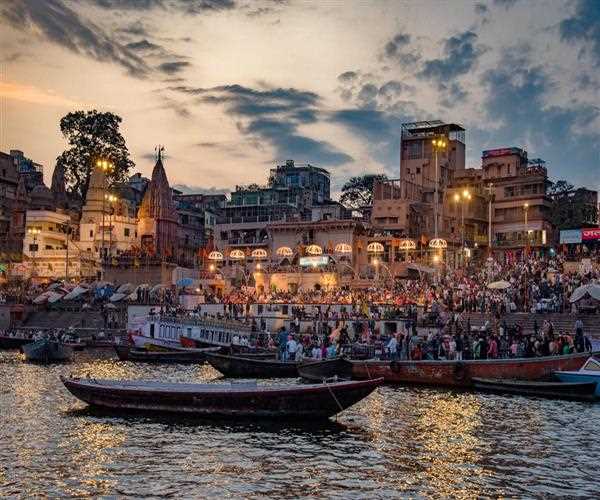
02-Jun-2024 , Updated on 6/2/2024 11:02:21 PM
Varanasi: The city of Moksha
Looking at the narrow lanes of Varanasi or which is known as Kashi or Banaras there is a building of special architectural signification for which people come to die to attain salvation. This city is referred to as ‘older than history’, ‘older than tradition’, and ‘older even than the legend’, and this hospice, Kashi Labh Mukti Bhawan specifically has rooms set aside for people who wish to die there and attain moksha, or liberation from rebirth.
A Place for the Final Journey
Kashi Labh Mukti Bhawan which was founded in the year 1958 by the Dalmiya Charitable Trust primarily consists of a two storeyed building which is situated at one of the most arterial points in Varanasi. To reiterate, it is home to the elderly who want to expire in this place and along with it, secure their liberation called moksha.
As per the tradition of The Bhawan, the guests are not expected to pay for their stay at the place or the rituals they opt for; the trust to which the place belongs looks after all the expenses, right from the lodge to the corpse. Thus, the hospice is a house of hope and spirituality, where elderly people come to accept their last days on earth.
The Essence of Kashi
Today, Varanasi has turned into one of the important cities in religious point of view, which has become the center attraction for thousands of people with different purposes. This is a city for the rites of passage: the birth ceremonies, the last rites, for deathbeds and safe passing places. Religion is also another important aspect in the life of the people of the city as they have strong belief in moksha which is the liberation from the rebirth.
You can see the misty view of the location and operations of Kashi Labh Mukti Bhawan, and you will realize that the hospice is not a business there. It’s often common to charge money in order to ensure the success of a business; however there everything ranging from food to rituals in order to ensure spiritual satisfaction is for free. The Bhawan has also opened doors to not only the Indian followers but also the international enthusiasts like from England, Japan, and even Mauritius to understand what moksha, life and death is all about.
The Path to Moksha
The pattern at Bhawan implies that the priests first examine the patients’ health and diagnose them before predicting the time they have on this earth. Surviving patients are taken care of depending on the time cycle up to 15-20 days after which the remaining stay is again extended. Overwhelmingly most of the patients receive moksha and there are no reports of people who did not get their destinies met within the hospital.
The Sacred Ghats of Varanasi
Opposite to Kashi Labh Mukti Bhawan, there stands Manikarnika Ghat, which is the main cremation ground out of the sixteen ghats in Varanasi. A priest at the ghat estimated that bodies numbering 32, 000 are cremated annually at this ghat. The tradition rooted in Hindu culture covers a body in white cloth and puts it to the cot made of bamboo.
Spiritual Aspect of Varanasi
Varanasi is recognised as one of the oldest living cities in the world that embraces a Spiritual Way of Life. This place is idolized as the place where lord Shiva resides and river Ganga which passes through the city of Allahabad has immense importance in Hindu religion. Thus, the waters of the river are held to wash all sins away, and most Hindus feel that to die in Varanasi would be to achieve moksha.
The temple of Kashi Vishwanath is dedicated to Shiva comprising one of the twelve Jyotirlingas in India. This temple was pulled down by Mughal Emperor Aurangjeb and was reconstructed by the Maratha queen Yeshwantaraje Malgovt.
Other Ghats of Varanasi
Ghats, there are are more than two-hundred foot the banks of Ganga, are located in Varanasi. All the ghats have different importance, Dashashwamedh Ghat organizes evening Ganga aarti and on the other hand Assi Ghat organizes morning aarti. Though this practice is becoming less common, Manikarnika Ghat and Harishchandra Ghat are places where funerals are still carried out.
A Personal Journey
Thus, for many people, Varanasi is not only a sacred place but a place that enriches the spiritual life of a person. Such audience energy generated by faith and devotion of the visitors makes the atmosphere of the city powerful. Sitting on the bank of the holy river Ganga and feeling the spirituality of the place is very refreshing.
Varanasi, for centuries and millenniums, has been that part of India where people come to attain salvation or in Indian term, ‘moksha’. The traditional and religious background of the city adds a special value to it as it offers hope and peaceful last moments to the people.

Student
An MBA in finance imparts and improves management aptitude, inventive ability, critical thinking ability, and so forth. It offers a real-time experience that fabricates a staunch career foundation for students and working professionals. It helps them to thoroughly understand the financial sector.
Join Our Newsletter
Subscribe to our newsletter to receive emails about new views posts, releases and updates.
Copyright 2010 - 2025 MindStick Software Pvt. Ltd. All Rights Reserved Privacy Policy | Terms & Conditions | Cookie Policy